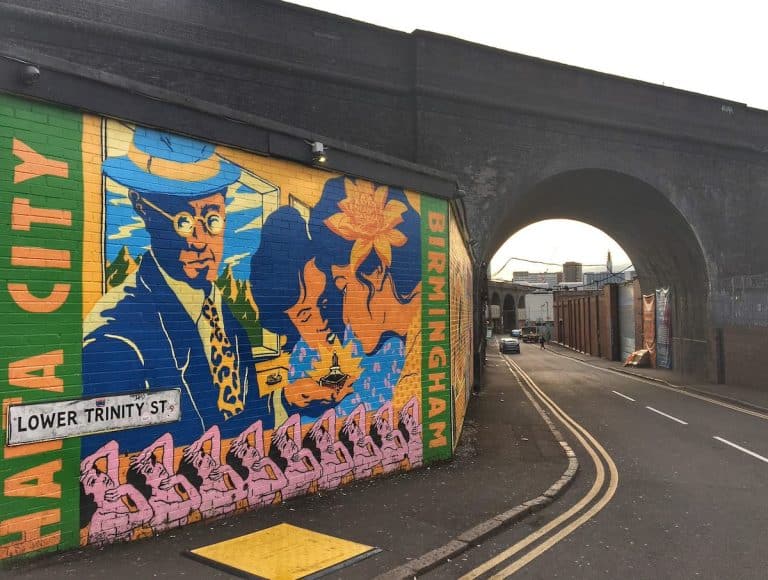Driving in The Cotswolds: Top Tips + Route Maps – Everything You Need to Know
PLANNING A ROAD TRIP THROUGH THE COTSWOLDS? WE’VE GOT YOU COVERED!
We’ve driven through the Cotswolds countless times, soaking in its rolling hills, honey-stone villages, and winding country lanes—without a single scratch on our rental car! As seasoned road-trippers, we’ve navigated narrow roads, dodged sheep, and mastered the art of Cotswolds driving.
And trust us—exploring the Cotswolds by car is absolutely worth it!
In this guide, we’ll share essential driving tips, the best scenic routes, and everything you need to know to confidently navigate this stunning region.
Let’s hit the road!
Need a Rental Car?
We recommend booking with DiscoverCars
✅ Easy booking process
✅ Offers comprehensive car insurance
✅ Excellent 24/7 customer service
What is Driving in the Cotswolds Like?
This Area of Outstanding Natural Beauty (AONB) is famous for its quaint villages, rolling countryside, and historic charm—but that also means narrow lanes, slow-moving tractors, and occasional traffic bottlenecks.
Driving in the Cotswolds promises a uniquely English experience, where every country lane leads to chocolate-box villages and rolling green hills, but those narrow country roads require some extra attention.
We don’t have rose-tinted glasses on. We admit that driving here can be challenging at times. Even with 18+ years of driving, I still feel a tad uneasy picking up speed on narrow country roads where the limit is 60mph – especially round tight bends!
You’ll encounter roads barely wider than your car, unexpected livestock crossings, and summer crowds in popular spots like Bourton-on-the-Water.
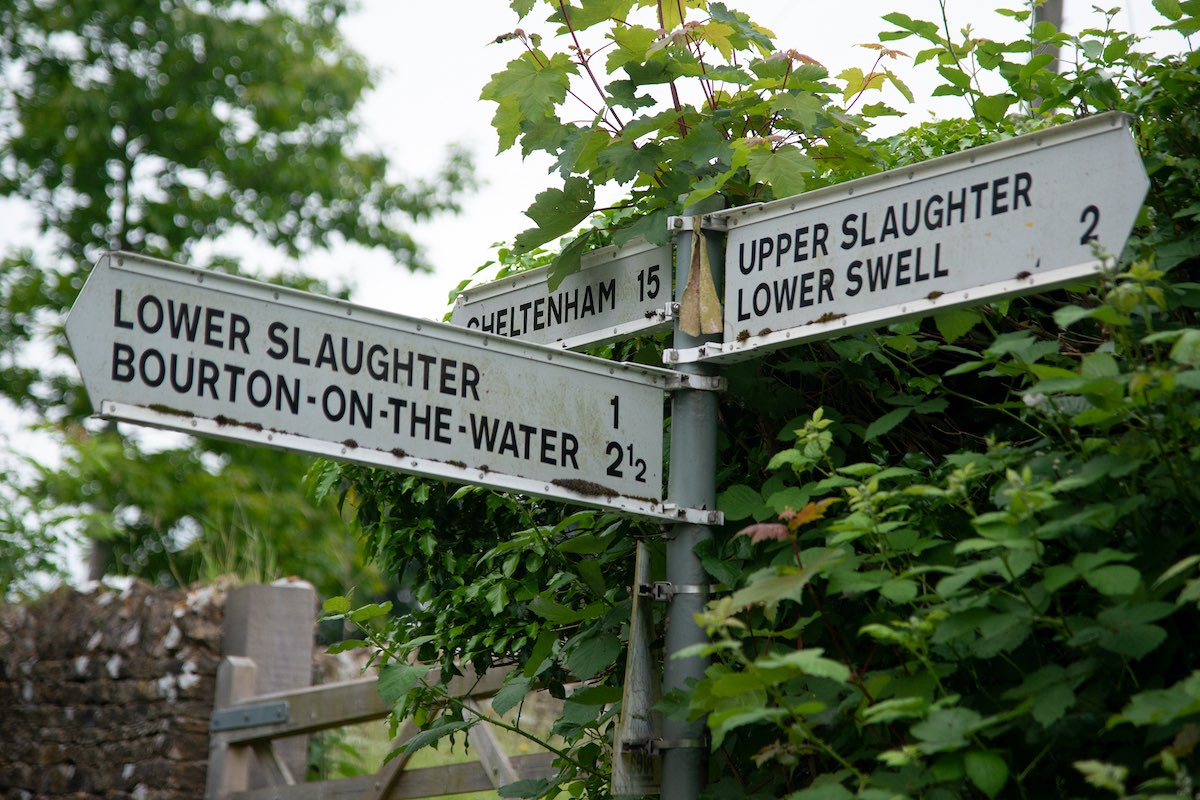
But here’s the truth we discovered on our 3-day Cotswolds trip: having your own wheels is a must. While buses can get you between major towns, only a car lets you discover those hidden hamlets, spontaneous picnic spots, and golden-hour photo opportunities that make this region magical.
Yes, you might need to reverse for a tractor or wait while sheep cross the road. But that’s all part of the authentic Cotswolds experience – and the freedom to explore at your own pace makes every minor challenge worthwhile.
Main UK Road Signs in the Cotswolds

12 ESSENTIAL COTSWOLDS DRIVING TIPS
Before you set off, here are our top tips for a smooth and enjoyable Cotswolds road trip.
#1. Remember: It’s Left-Hand Driving Here
Just like the rest of the UK, driving in the Cotswolds means keeping to the left side of the road. If you’re visiting from North America or Europe where driving is on the right, this will take some getting used to – especially at roundabouts where traffic flows clockwise.
Rental cars will have the steering wheel on the right side, and while most are manual transmission, you can request an automatic (though these often come at a premium).
Looking to rent a car in the Cotswolds?
➡️ Book your rental car with DiscoverCars HERE!
→ Further reading: West Midlands Guide (Best Time to Visit, Weather, Activities)
#2. Narrow Roads Require Extra Caution
Many Cotswolds lanes are single-track roads barely wider than your car, with occasional passing spots carved into the hedgerows. These stone-walled lanes often have blind bends, so take them slowly.
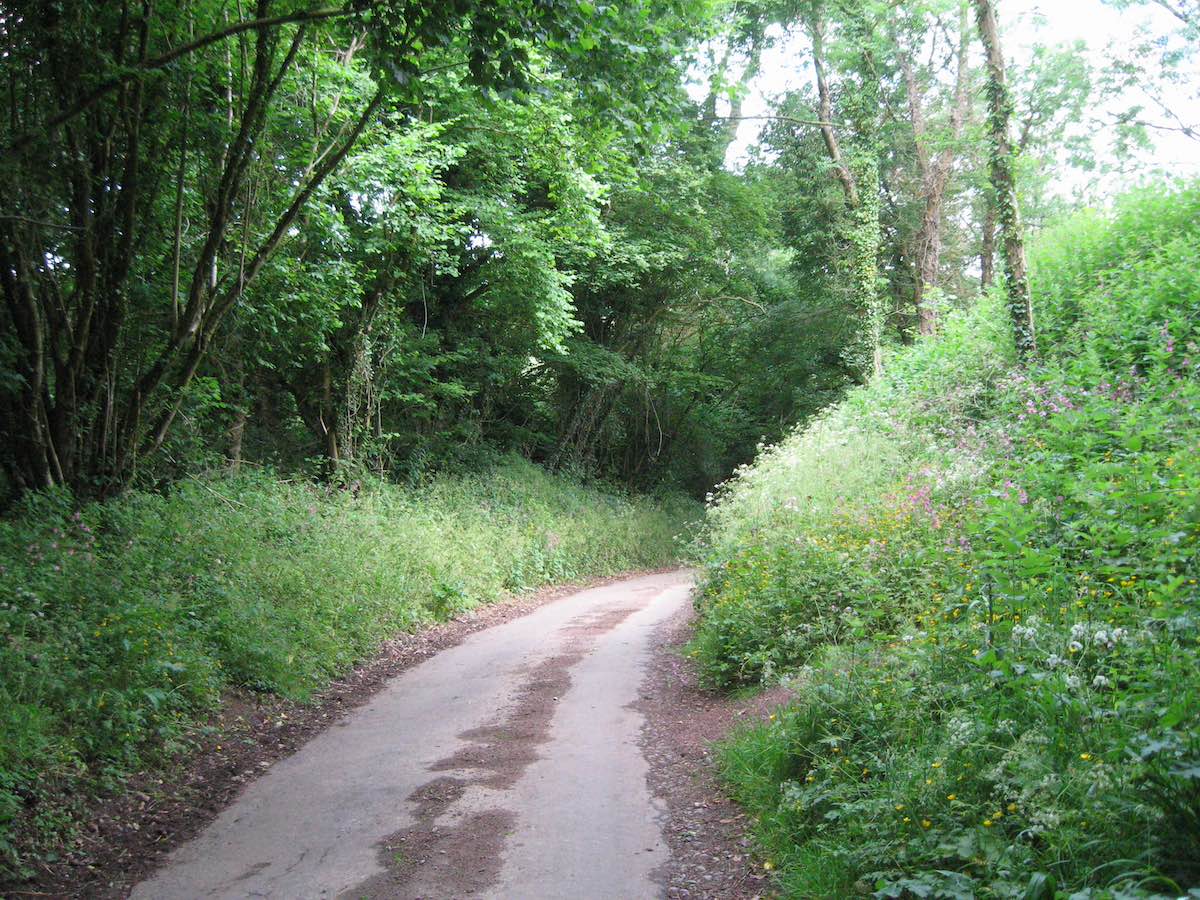
If you encounter an oncoming vehicle (especially a tractor or delivery truck), the general rule is that whoever is closest to a passing space should reverse. Don’t be surprised if you need to back up 50 yards to let farm equipment through – it’s all part of the rural driving experience.
✨ Driving Tip: Learn the Cotswolds Wave – on narrow lanes, locals often raise their index finger from the steering wheel to thank drivers who pull over. It’s a small gesture, but it keeps things friendly!
Looking to rent a car in the Cotswolds?
➡️ Book your rental car with DiscoverCars HERE!
#3. Wildlife and Livestock Have Right of Way
Sheep, cows, and pheasants frequently wander onto Cotswolds roads, particularly around dawn and dusk. Hitting a sheep not only damages your car but can result in hefty fines from farmers.
When you see animal warning signs, slow down and be prepared to stop suddenly. Some country lanes even have special “sheep grids” – drive over these slowly to avoid damaging your tires.
Common Animal Signs in the Cotswolds
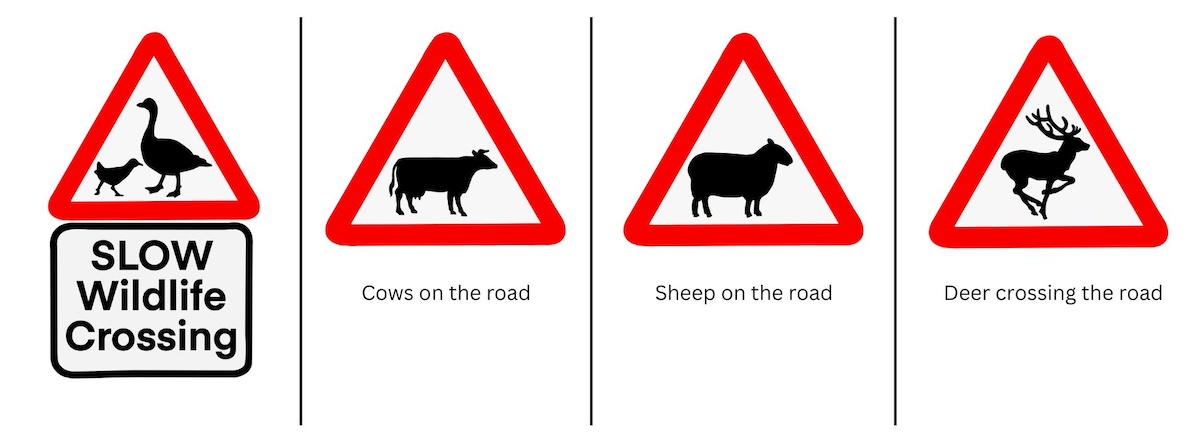
What’s the best time of year to drive in the Cotswolds?
✔️ Spring & Autumn—fewer crowds, beautiful colours.
✔️ Winter can be magical but watch for frosty lanes.
❌ Summer weekends get very busy—arrive early!
→ Read more: National Trust vs English Heritage: Which is Better?
#4. Parking Requires Strategy
Parking in the Cotswolds requires some clever planning. In popular villages like Bourton-on-the-Water or Bibury, spaces fill up fast – aim to arrive before 9:30am or visit after 5pm when most day-trippers have left.
Is parking easy in the Cotswolds?
Parking can be tight in honey-pot villages like Bibury or Bourton-on-the-Water. Arrive before 10am or use pub car parks (with a purchase). Larger towns (Cheltenham, Cirencester) have paid lots. And just to be safe, always carry coins for older meters.
While some villages offer limited free parking, many require paying at machines – and here’s an important tip: keep £1-2 coins handy as some older machines (especially in smaller villages like Snowshill) don’t accept cards. On the other hand, you can pay on a parking app at many places too.
✨ Local secret: many country pubs allow 1-2 hours of free parking if you buy a drink (just check the signs first).
Parking Payment Apps for the Cotswolds
Most Cotswolds car parks use RingGo or PayByPhone for cashless payments. Save these app codes for quick access:
RingGo
Bourton-on-the-Water:
✪ Rissington Road Car Park (Code: 804760)
✪ Bourton Vale Car Park (Code: 806323)
PayByPhone
Bourton-on-the-Water:
✪ Pay and Display Car Park (Code: 41644)
Moreton-in-Marsh:
✪ Old Market Way Car Park (Code: 804761)
Cheltenham:
✪ Royal Well Car Park (Code: 7289)
✪ Sherborne Place Car Park (Code: 7283)
Cirencester:
✪ Brewery Car Park (Code: 804752)
✪ Sheep Street Car Park (Code: 804757)
✨ Pro Tip: For National Trust sites (e.g., Hidcote), use PayDisplay instead.
During our Cotswolds road trips, we occasionally found free parking in the most beautiful towns in the Cotswolds, like outside the White Hart Hotel in Moreton-in-Marsh, and Fosseway Car Park in Stow-on-the-Wold.
⚠️ Word of warning: Never block farm gates or park on verges – not only is it inconsiderate, but you risk getting clamped and towed, or earning the wrath of local farmers.
✨ How to Explore the Villages, hassle-free
Connect the dots between picturesque but spread-out villages without the hassle of driving and parking. A guided walking tour lets you soak in the details you’d miss from a car. We recommend Macs Adventure for their highly-rated, detailed, customisable tours.
#5. Fuel Stations Are Few and Far Between
Petrol stations become scarce once you leave market towns like Cheltenham or Cirencester. We recommend filling up whenever your tank hits half full, especially if you’re heading into more remote areas.
Most stations are self-service and accept card payments, though some rural ones may close early in the evening.
✨ Budget Tip: I always avoid expensive stations like Shell, Texaco and BP which charge far more per gallon. Instead, I opt for Sainsburys or Tesco – especially the latter so I can earn Clubcard points with each refill.
Zoom in and search the map below to see all the available petrol stations in the Cotswolds, and specifically, the petrol companies:
▶︎ Blue pins = cheapest
(lowest price per gallon): Sainsbury’s, Tesco, Morrisons, Asda. Our recommended spots.
▶︎ Yellow pins = more expensive brands:
Esso, Texaco, Shell, BP. Some people prefer these for the supposedly high-quality diesel for expensive cars.
▶︎ Red pins = Expensive motorway service stations
Shell, BP – extortionate service station prices, avoid if possible.
→ For more useful Cotswolds maps, head over to our collection of free PDF Cotswolds Maps post here:
EV Charging Points in the Cotswolds
Electric vehicle drivers will find chargers in market towns (Cheltenham, Stow, Cirencester), but rural coverage is sparse. Here’s some key tips:
➡️ Top up at BP Pulse (Cheltenham) or Pod Point (Burford).
➡️ Some hotels like Number Four at Stow offer private chargers – call ahead or book your stay with them here:
Use the map below to see the top EV charging stations in the Cotswolds based on user feedback and reviews:
⚡️ Book Your Stay at an EV Charging Spot Hotel
For the EV drivers out there we know how important having a private overnight charger station is. Here are our recommended EV charger hotel options:
◉ Budget: Tewkesbury Park (Superior double with terrace) – a stunning Georgian manor with hot tub, spa, golf course and more at great value. Rating: Fabulous 8.8
◉ Luxury: Whatley Manor, Malmesbury (Deluxe suite) – boasts celebrity treatment and world-class service with a Michelin-starred restautrant, and one of the UK’s top 10 spa retreats offering Sothy’s treatment. Rating: Superb 9.1
→ You may also like: 10 Best Family Days Out West Midlands
#6. Timing Matters Around Larger Towns
While most of the Cotswolds feels blissfully rural, timing your drives makes a big difference. Areas near Cheltenham, Gloucester and Oxford experience proper rush hours (7:30-9:30am and 4:30-6:30pm).
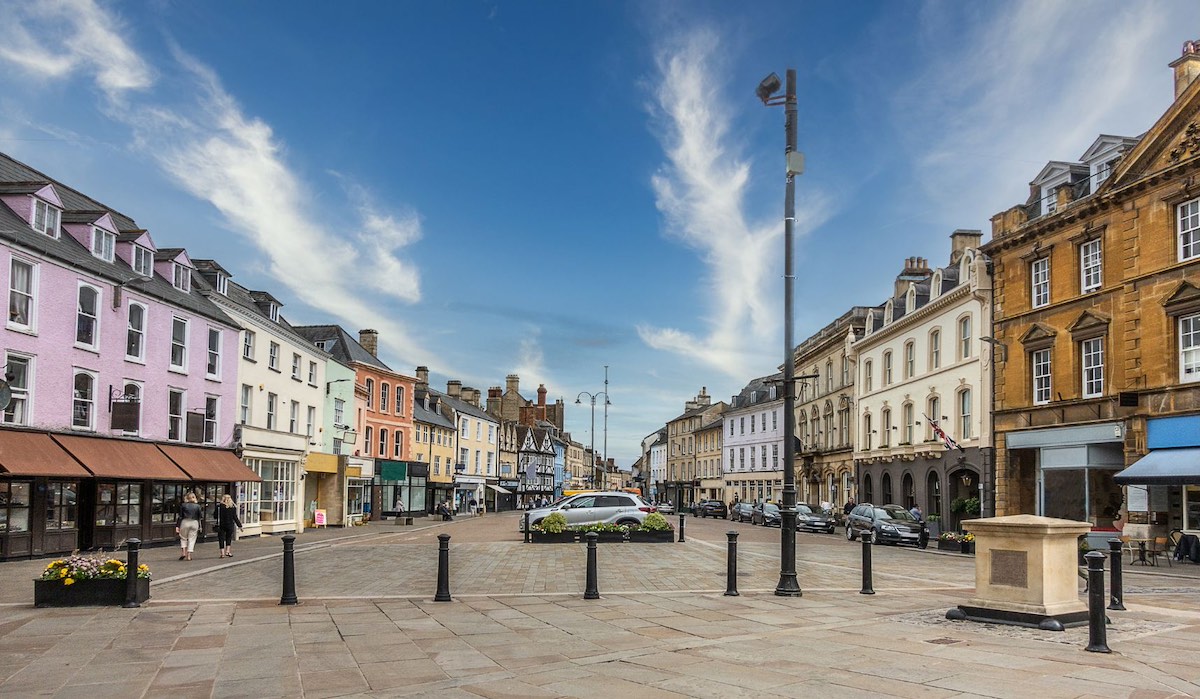
But here’s the golden rule for weekenders: avoid the A40 and A429 completely between 4-7pm on Sundays when everyone heads back to London – either leave before 3pm or take the quieter A417 route instead.
For sightseeing, weekdays (Tuesday-Thursday) are significantly quieter than weekends when the Cotswolds gets busiest with both international visitors and UK staycationers.
Looking to rent a car in the Cotswolds?
➡️ Book your rental car with Discover Cars HERE!
#7. Use a Reliable GPS (But Always Carry a Backup Map)
Mobile signals vanish quickly in the Cotswolds valleys, making offline navigation essential. While Google Maps works for main roads, it often misses the rural footpaths and scenic byways that make this region special.
For serious explorers, I recommend two failsafe options:
✅ The OS Maps App – Covers every footpath, bridleway, and elevation change in real-time (perfect for finding hidden gems like wildflower meadows near Winchcombe).
✅ Waterproof Paper Maps (OL45) – Never loses signal and reveals details smartphone maps ignore, like ancient rights-of-way through private farmland.
OS Map Features:
★ Trails suitable for cyclists and horse riders
★ Terrain gradients crucial for tackling the Cotswold Way
★ Nature reserves including Cleeve Common (Special Scientific Interest)
★ Historic sites for visitors marked along all major routes
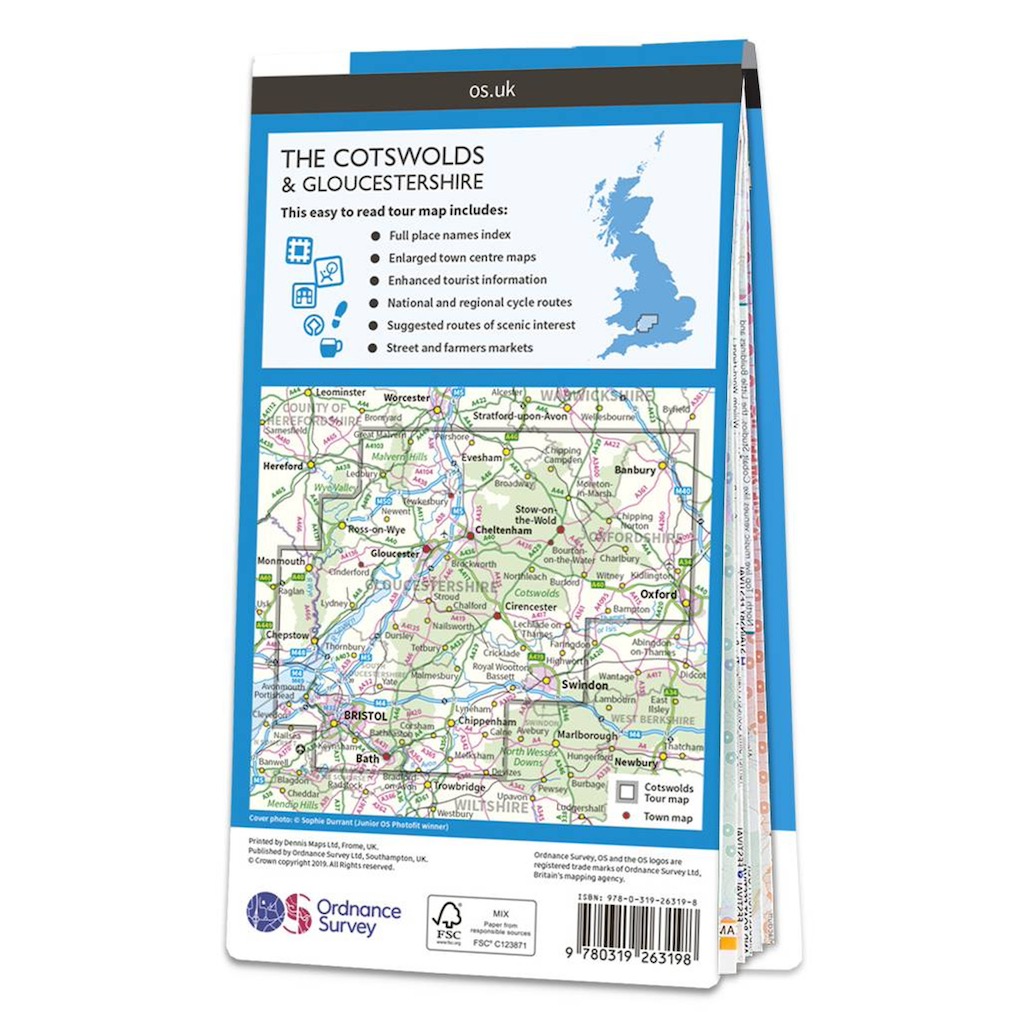
✨ Pro Tip: I never drive without both. The app is ideal for real-time tracking, while a paper map helps when batteries die or you need to plan detours around unexpected road closures.
➡️ Get 50% Off the OS Maps App HERE
➡️ Buy Waterproof Paper Maps HERE
Another useful hack: look for village laybys (like the gravel pull-off near Arlington Row in Bibury) for quick photo stops without blocking traffic. These unofficial parking spots are perfect for snapping that iconic shot without holding up other drivers.
Having a paper map as backup isn’t a bad idea either for those truly remote areas.
→ You may also like: 10 Best Family Days Out West Midlands
#8. Speed Limits & Hidden Cameras
The national speed limit is 60mph on single carriageways (and 70mph on dual carriageways), but 60mph is often dangerously fast for the winding Cotswolds lanes. In villages, the limit drops to 30mph – and be warned, these are strictly enforced by speed cameras in certain areas (the A40 near Burford is particularly notorious).
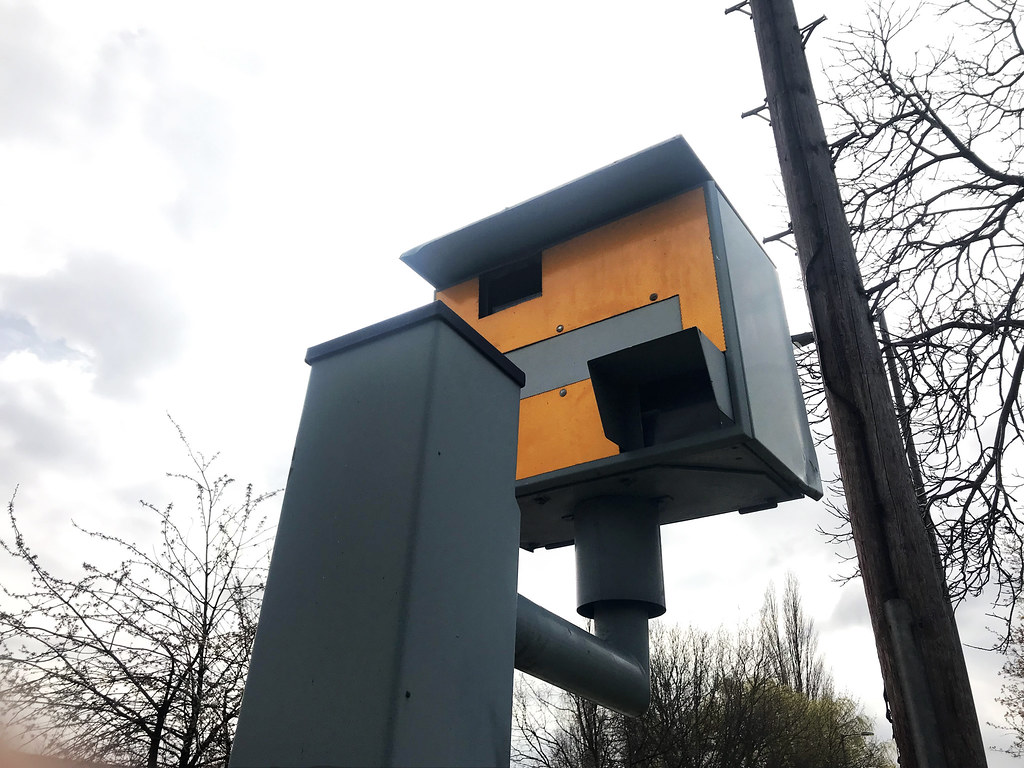
Country roads are usually 40-50mph, but you’ll often need to go slower due to blind bends or livestock. Watch for sudden changes in speed limits when entering villages – the locals know where the cameras are, but visitors often get caught out.
Want to explore the Cotswolds’ ancient long barrows, Roman villas, and medieval ruins?
With an English Heritage Visitor Pass, you can enjoy unlimited access to 15+ historic sites across the Cotswolds National Landscape, including:
→ Belas Knap Long Barrow (a 5,000-year-old Neolithic tomb)
→ Cirencester Amphitheatre (one of Britain’s largest Roman arenas)
→ Hailes Abbey (haunting 13th-century Cistercian ruins)
→ Minster Lovell Hall (a picturesque 15th-century manor by the River Windrush)
Your OS Explorer Map covers all these sites plus trails linking them – perfect for combining history with scenic walks. Save 10% versus individual tickets and discover the Cotswolds’ layered past at your pace.
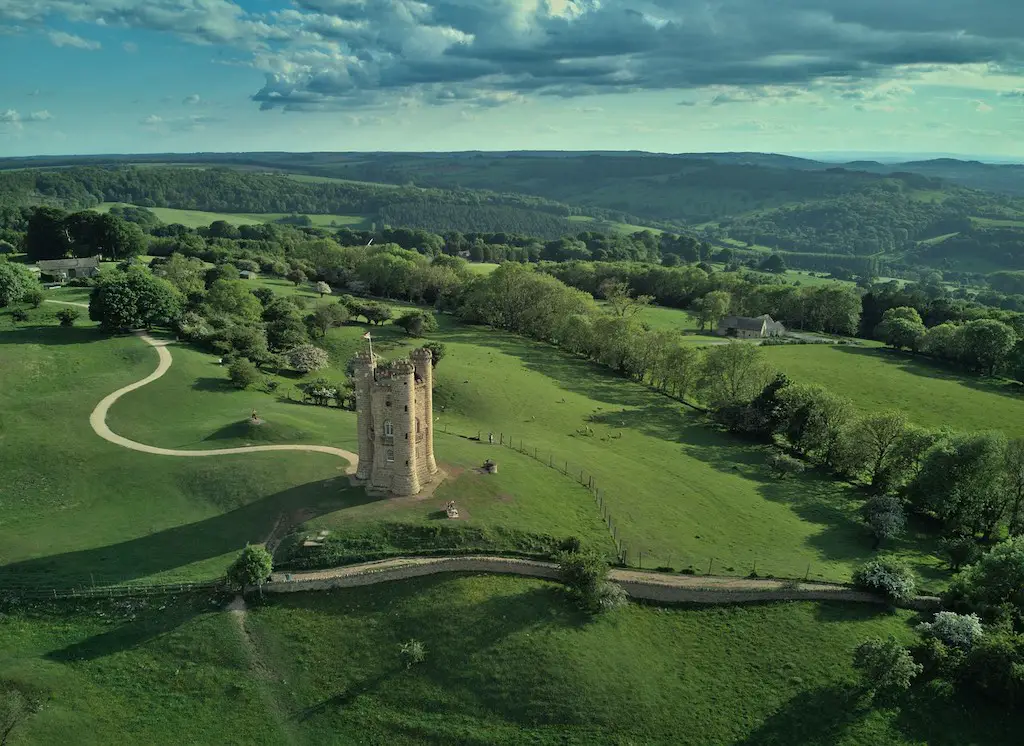
Tip: Pair your pass with an OS Explorer Map to navigate between sites like the Rollright Stones and Great Witcombe Roman Villa with ease.
→ Related post: Explore the Midlands with English Heritage Membership
#9. Master the Art of Roundabouts
UK roundabouts can confuse visitors – remember to give way to traffic coming from your right, and signal before exiting. Smaller village roundabouts may not have clear markings, so approach them cautiously. When in doubt, wait and let other drivers go first until you’re comfortable with the flow.
What is the prettiest street in the Cotswolds?
Arlington Row in Bibury is the iconic choice—a line of 17th-century weavers’ cottages beside a willow-lined river. For less crowds, try Church Street in Snowshill or The Square in Stanton, both untouched by time.
→ See also: Paddleboarding in the West Midlands: Our Top 10 Spots
#10. Choose Your Rental Car Wisely
A compact car is ideal for Cotswolds driving – you’ll appreciate the smaller size when squeezing past stone walls or parking in tight village spots. While automatics are available, they typically cost more to rent. Consider paying extra for a car with parking sensors, which are incredibly helpful on these narrow lanes.
Looking to rent a car in the Cotswolds?
➡️ Book your rental car with Discover Cars HERE!
#11. License and Insurance Essentials
International visitors can drive in the UK with a valid license from their home country (no IDP required if the license is in English). Rental companies usually require drivers to be aged 18 at minimum with at least one year of driving experience.
While basic insurance is included with rentals, we always opt for comprehensive coverage – those stone walls and narrow lanes make minor scrapes surprisingly common.
To drive in the UK (including the Cotswolds), you must be at least 17 years old (18+ for rental cars) and hold a valid driver’s license from your home country.
EU/EEA licenses are accepted. For US, Canada, Australia, etc., check if your license is in English—if not, carry an International Driving Permit (IDP) or official translation.
Rental companies typically require a license held for 1+ year and a credit card in the driver’s name.
Insurance Requirements:
– Third-party liability insurance is the UK legal minimum, but rental cars usually include this.
– Collision Damage Waiver (CDW) reduces your liability for damage—but often has excess fees (£500–£1,500).
✨ Helpful Tip: I always book fully comprehensive insurance (via rental agencies or third parties like RentalCover.com). It covers:
☑️ Vehicle damage/theft (zero or low excess)
☑️ Personal injury
☑️ Third-party property damage
☑️ Windshield/chip repairs (common on rural roads!)
Pro Advice:
- Compare rental agency vs. external insurer prices—booking in advance is often cheaper.
- Read the fine print (e.g., off-road or gravel road exclusions).
- Ask the rental company where to park overnight (some policies void coverage for street parking).
Staying in the Cotswolds?
We recommend Stow-on-the-Wold as one of the best places to base yourself in the Cotswolds due to its close proximity to many of the villages in this guide.
◉ For budget travellers, The Redesale Arms Hotel is an excellent option rated very good 8.4.
◉ And for luxury, I recommend this superb, 4-bed home rated exceptional 9.6, that comes with a hot tub!
Not sure where to stay in the Cotswolds? Our Best Hotels in the Cotswolds [+ Strategic Maps Guide] has got you covered!
→ You may also like: Brummie Slang by a Local: Ultimate Guide
#12. Alcohol and Mobile Phone Laws

The UK has strict drink-driving laws (0.08% BAC limit) with random breath tests, so if you’re enjoying the local ales at Cotswolds pubs, just make sure you limit yourself to 1 drink to avoid exceeding the limit, otherwise, designate yourself a driver or take a taxi.
Mobile phone use while driving is illegal – technically, holding and using a mobile while driving is an offense. You’re better off setting up Bluetooth or using your mobile map hands-free (hit the ‘start’ button before taking off), or just pull over safely if you need directions.
Looking to rent a car in the Cotswolds?
➡️ Book your rental car with Discover Cars HERE!
BEST SCENIC DRIVING ROUTES IN THE COTSWOLDS
Now for the fun part—the most beautiful drives in the Cotswolds!
1. The Cotswolds Drive (Classic Villages Route)
Route: Bourton-on-the-Water → Lower Slaughter → Upper Slaughter → Stow-on-the-Wold → Moreton-in-Marsh
Highlights: Iconic honey-stone villages, river walks, and charming tea rooms.

This quintessential Cotswolds drive packs in the region’s most photographed spots. Start in Bourton-on-the-Water, where low stone bridges cross the River Windrush, before taking the quiet lane to the Slaughters—two impossibly pretty villages with wandering streams and old mills.
From there, wind up to Stow-on-the-Wold, a historic market town with antique shops and cosy pubs, then finish in Moreton-in-Marsh, where a traditional high street offers the perfect tea stop.
✔️ Best for: First-time visitors who want the postcard-perfect Cotswolds.
✦ Quirky attraction: If you have time, visit the Dragonfly Maze in Bourton – one of the best Outdoor Mazes in the Midlands. It’s not just a maze, but a puzzle too – can you find the golden dragonfly at the centre?
2. The Romantic Road (North Cotswolds)
Route: Chipping Campden → Broadway → Snowshill → Stanton
Highlights: Rolling hills, historic market towns, and Broadway Tower views.
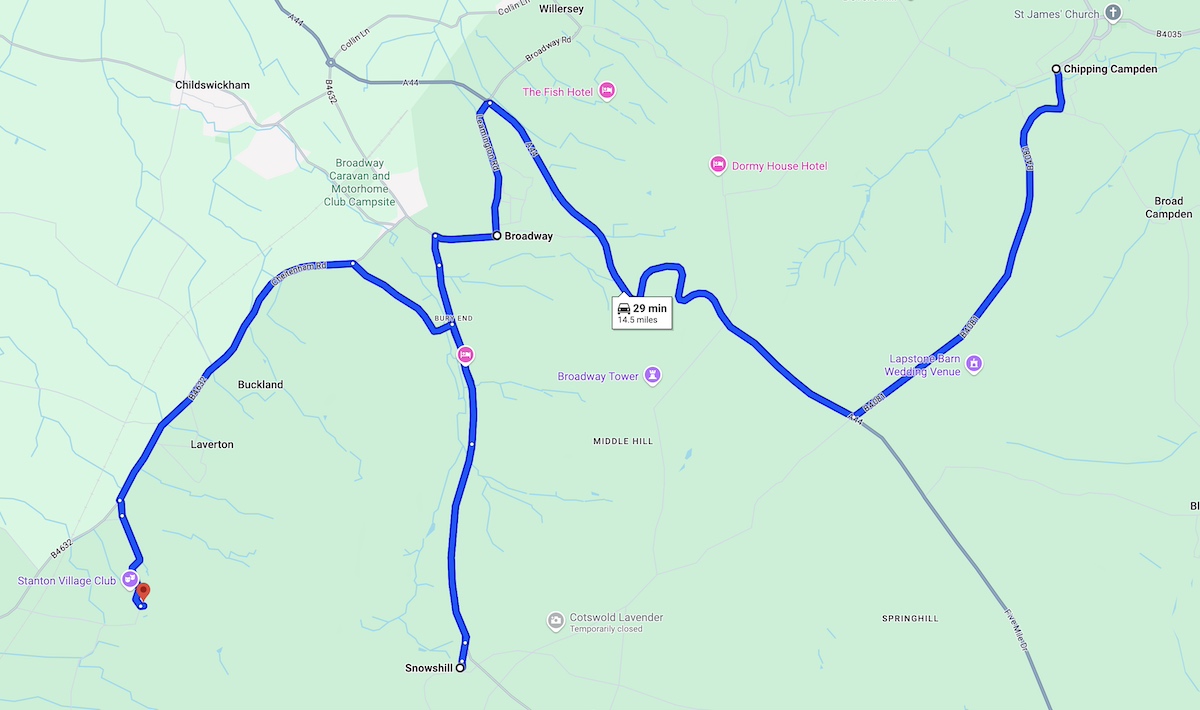
For drama and romance, this northern route delivers. Begin in Chipping Campden, a masterpiece of medieval wool-trade wealth, then follow the ridgeline to Broadway, where the iconic Broadway Tower offers panoramic views.
The road then dips through Snowshill, a tiny village with an eccentric manor house, before ending in Stanton, a hidden gem with a sloping high street untouched by time.
✔️ Best for: Rolling hills and honey-stone architecture at its finest.
→ Read more: Warwickshire Maps & Guides (Free PDFs)
3. The Southern Cotswolds Explorer
Route: Tetbury → Westonbirt Arboretum → Malmesbury → Castle Combe
Highlights: Forest drives, historic abbeys, and “the prettiest village in England” (Castle Combe).
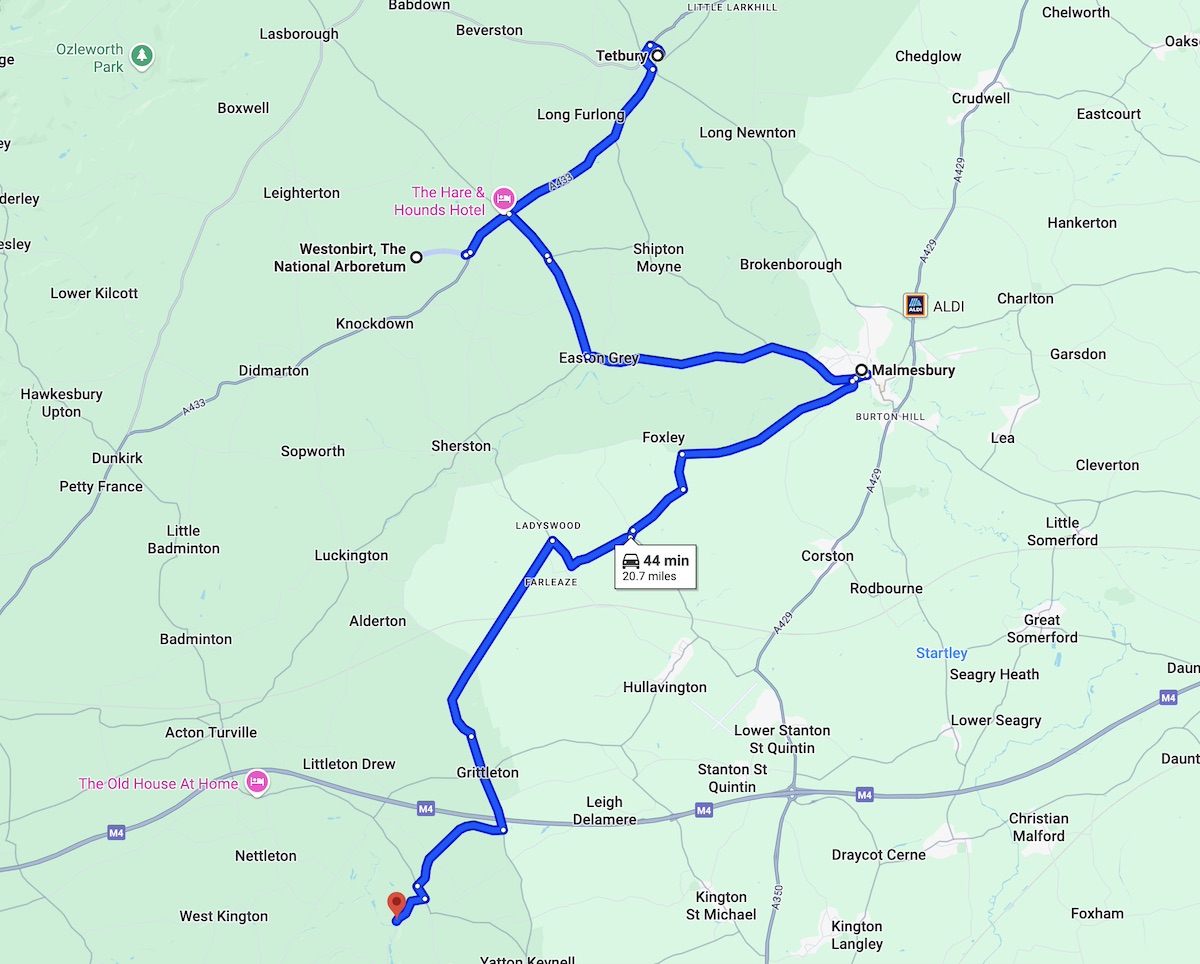
A quieter alternative, this southern circuit mixes woodland beauty with history. Tetbury’s antique shops and royal connections (Highgrove House is nearby) make a great start, followed by the Westonbirt Arboretum, where tree-lined drives glow fiery red in autumn.
Then head to Malmesbury, England’s oldest borough, before finishing in Castle Combe, often called “the prettiest village in England” with its picture-perfect bridge and cottages.
✔️ Best for: Autumn colours and off-the-beaten-path charm.
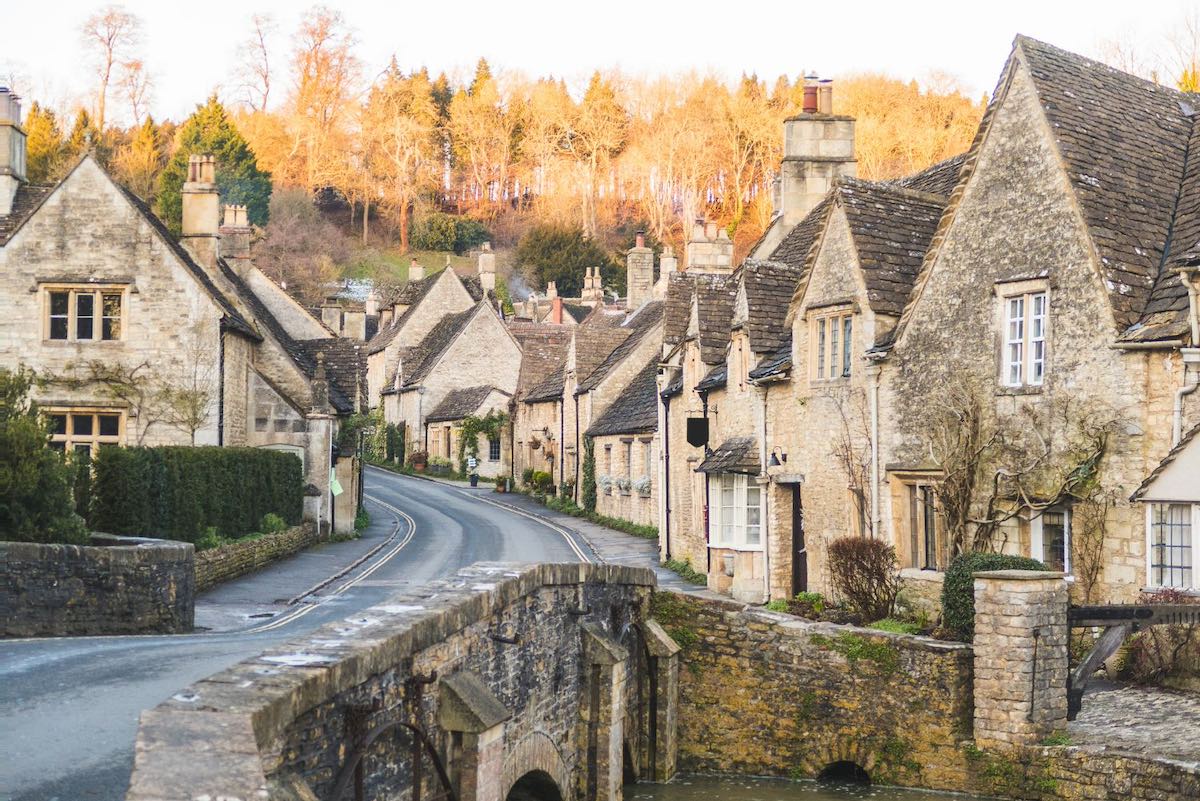
4. The Windrush Valley Drive
Route: Burford → Minster Lovell → Witney → Woodstock (Blenheim Palace)
Highlights: River valleys, medieval ruins, and Blenheim Palace’s grandeur.
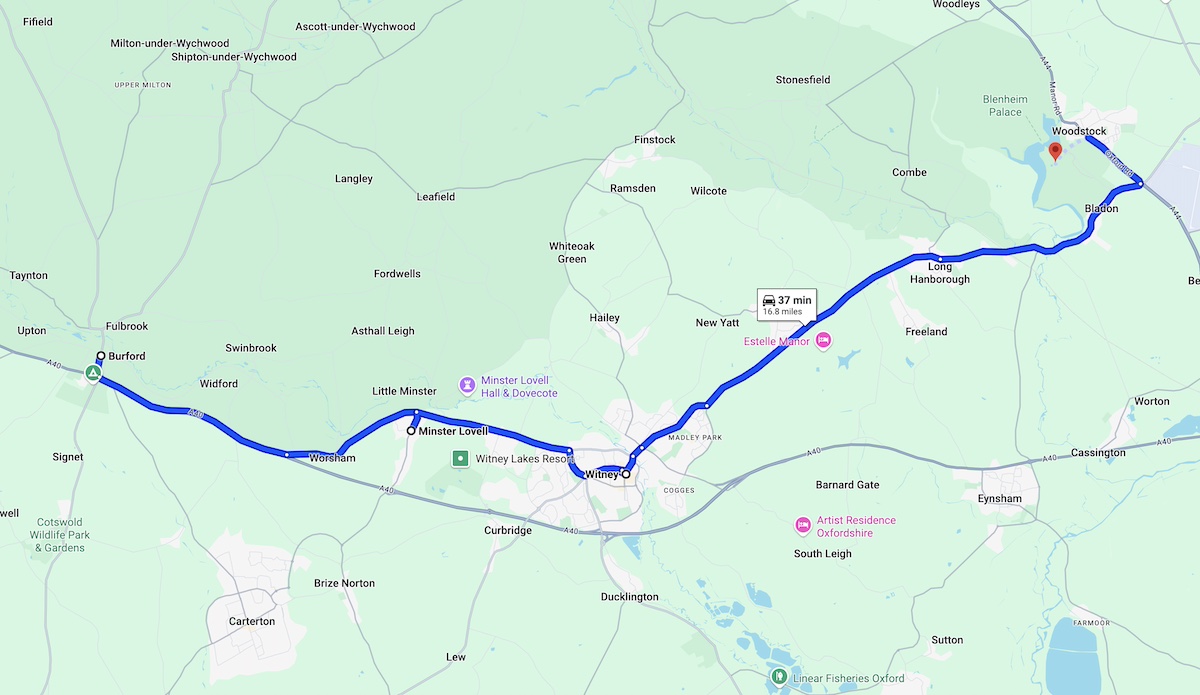
This route follows the River Windrush through quintessential countryside. Burford’s steep high street and medieval bridge set the tone, while the ruins of Minster Lovell (a 15th-century manor) make a hauntingly beautiful stop.
After a quick detour to Witney for its blanket-making heritage, end at Woodstock, where Blenheim Palace—Churchill’s birthplace—awaits with its grand parkland.
✔️ Best for: History lovers and grand estate scenery.
Looking to rent a car in the Cotswolds?
➡️ Book your rental car with Discover Cars HERE!
Is driving in the Cotswolds difficult?
Driving here requires extra caution due to narrow lanes, blind bends, and occasional livestock crossings. While not technically difficult, it demands patience—especially for visitors unfamiliar with left-hand driving or rural roads. Stick to main routes if nervous, and avoid rush hours near towns like Cheltenham.
What is the best driving route in the Cotswolds?
The Classic Villages Loop (Bourton-on-the-Water → The Slaughters → Stow-on-the-Wold) offers quintessential Cotswolds charm. For drama, try the Romantic North Route (Chipping Campden → Broadway Tower). Both pack stunning scenery into under 30 miles, with plenty of tearoom stops.
Do you need a car in the Cotswolds?
Yes, to explore properly. While buses connect major towns, they’re infrequent. A car lets you discover hidden hamlets, scenic viewpoints, and off-peak gems. For a car-free trip, base yourself in Cheltenham and join tours.
Is the Cotswolds flat or hilly?
Rolling hills dominate this region, especially near the Cotswold Escarpment (steep around Broadway and Cleeve Hill). The south (Tetbury, Malmesbury) is gentler. Even flatter valleys have subtle gradients—manual drivers should prepare for hill starts and parking.
Is north or south Cotswolds better?
North (Chipping Campden, Broadway) has dramatic hills and wool-town grandeur. South (Castle Combe, Westonbirt) feels quieter, with lush forests. We recommend the north as a priority for first-timers; while return visitors may be better suited to exploring the south’s hidden valleys.
Plan Your Perfect Cotswolds Trip
Your maps are sorted! Now, use our detailed guides to build the rest of your itinerary:
➡️ Your Complete Itinerary: Follow our step-by-step guide for the perfect Cotswolds 3-Day Itinerary, designed to show you the very best of the region.
➡️ What to See: Discover the picture-perfect locations you’ll be visiting with our guide to 17 Charming Cotswolds Villages.
➡️ Where to Stay: Dive deep into our curated list of the 8 Best Hotels in the Cotswolds for every budget.
➡️ Free Cotswolds Maps: To help you visualise your journey and locate all these spots, be sure to bookmark our central Cotswolds Maps page.
➡️ Where to Eat & Drink: Experience local flavour at the finest Cotswolds Pubs, from rustic inns to gastro pubs.
Use the maps on this page to locate all these incredible hotels, villages, and pubs during your trip!
Final Thoughts – is Driving in the Cotswolds worth it?
Absolutely! While the narrow roads and occasional traffic require patience, nothing beats the freedom of exploring the Cotswolds by car. You’ll discover hidden gems, stop for cream teas, and soak in breathtaking views—all at your own pace.
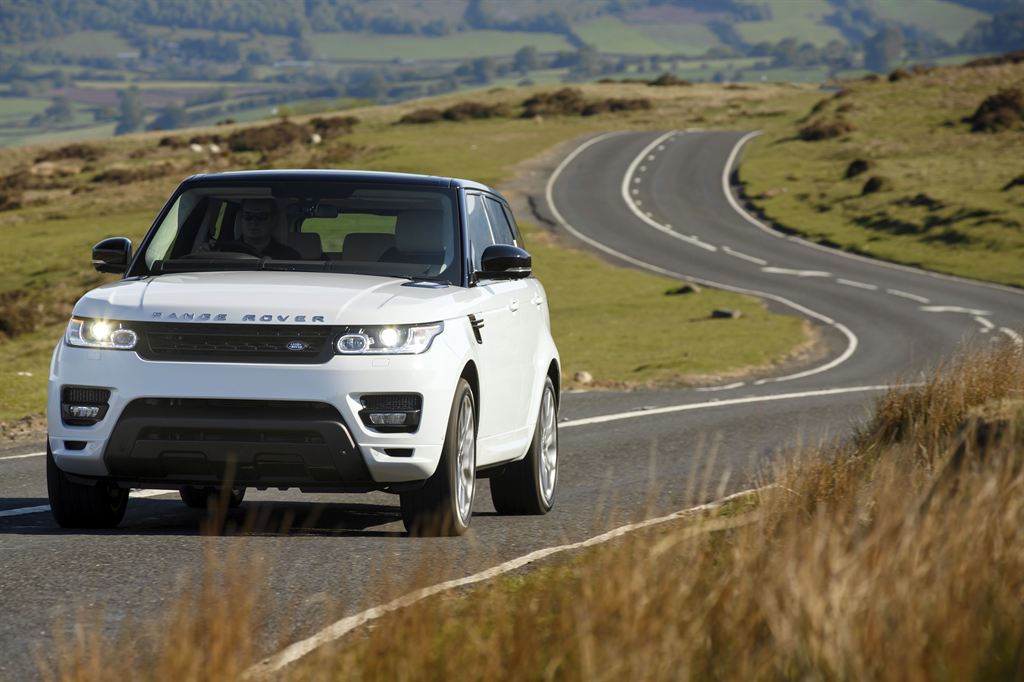
Just take it slow, respect local drivers, and enjoy the journey. The Cotswolds is one of England’s most beautiful regions, and driving through it is an experience you’ll never forget. Happy driving!
Ready to rent a car?
➡️ Compare the best rental deals with Discover Cars HERE!
Download your FREE Cotswolds PDF Packing List Here
This list features our recommendations on what to pack for the Cotswolds in each season, with only the most trusted travel gear that we’ve used for years (plus some things that most tourists forget too!)
Final Tips for Your Cotswolds Trip
✅ Purchase a laminated OS Explorer Map if you plan serious walking – the weather can change quickly in this landscape.
✅ The OS Maps App (50% off here) provides excellent real-time directions across all trails with the location of most popular and hidden gem attractions
✅ Respect the wildlife – stick to marked trails and rely on the Countryside Code.
✅ Consider visiting in shoulder seasons (April-May or September-October) to avoid crowds.
✅ Combine your trip with visits to nearby regions like the Wales border or Oxford for extended exploration.








